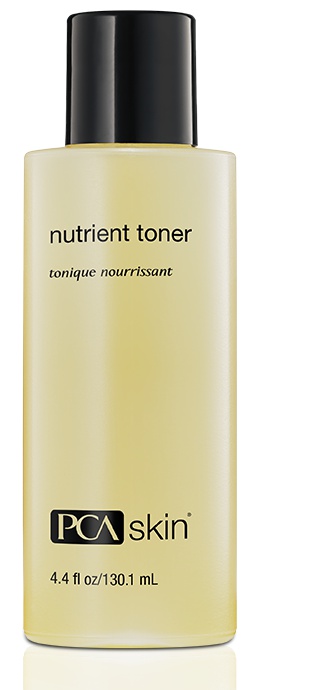
Nutrient Toner
Highlights
Skim through
| Ingredient name | what-it-does | irr., com. | ID-Rating |
|---|---|---|---|
| Water/Aqua/Eau | solvent | ||
| Lactobacillus/Pumpkin Ferment Extract | exfoliant | goodie | |
| Sucrose | moisturizer/humectant, soothing | goodie | |
| Lactic Acid | exfoliant, moisturizer/humectant, buffering | superstar | |
| Propylene Glycol | moisturizer/humectant, solvent | 0, 0 | |
| Citric Acid | buffering | ||
| Glutathione | |||
| Aminoguanidine Hcl | |||
| Yeast | moisturizer/humectant | goodie | |
| Eugenia Caryophyllus (Clove) Leaf Oil | perfuming | ||
| Cinnamomum Cassia Leaf Oil | perfuming | ||
| Zingiber Officinale (Ginger) Root Oil | perfuming | ||
| Alcohol Denat | antimicrobial/antibacterial, solvent, viscosity controlling | icky |
PCA Skin Nutrient TonerIngredients explained
Good old water, aka H2O. The most common skincare ingredient of all. You can usually find it right in the very first spot of the ingredient list, meaning it’s the biggest thing out of all the stuff that makes up the product.
It’s mainly a solvent for ingredients that do not like to dissolve in oils but rather in water.
Once inside the skin, it hydrates, but not from the outside - putting pure water on the skin (hello long baths!) is drying.
One more thing: the water used in cosmetics is purified and deionized (it means that almost all of the mineral ions inside it is removed). Like this, the products can stay more stable over time.
When you hear pumpkin you probably think of Halloween or autumn, but it turns out that many forms of pumpkin are also great skincare ingredients.
This particular form is obtained by fermenting the pumpkin fruit with lactobacillus lactis. During the fermentation, many of the complex biomolecules are broken down into isolated phytochemicals and selective filtration techniques are used to isolate the proteolytic parts. The result is pumpkin enzyme that is a gentle exfoliator that can be an alternative to AHAs.
According to the manufacturer, 4% glycolic acid has a similar effect on cell renewal as 5% pumpkin enzyme. In an irritation test, the ingredient did not irritate even the sensitive eye tissue and was hardly more irritating than glycerin.
All in all, pumpkin enzyme seems to be a promising gentle alternative to acid exfoliation.
A type fo sugar, usually refined from cane or beet sugar. On the skin, it has water-binding properties and helps to keep your skin hydrated.
- It’s the second most researched AHA after glycolic acid
- It gently lifts off dead skin cells to reveal newer, fresher, smoother skin
- It also has amazing skin hydrating properties
- In higher concentration (10% and up) it improves skin firmness, thickness and wrinkles
- Choose a product where you know the concentration and pH value because these two greatly influence effectiveness
- Don’t forget to use your sunscreen (in any case but especially so next to an AHA product)
- It's a helper ingredient that improves the freeze-thaw stability of products
- It's also a solvent, humectant and to some extent a penetration enhancer
- It has a bad reputation among natural cosmetics advocates but cosmetic scientists and toxicology experts do not agree (read more in the geeky details section)
Citric acid comes from citrus fruits and is an AHA. If these magic three letters don’t tell you anything, click here and read our detailed description on glycolic acid, the most famous AHA.
So citric acid is an exfoliant, that can - just like other AHAs - gently lift off the dead skin cells of your skin and make it more smooth and fresh.
There is also some research showing that citric acid with regular use (think three months and 20% concentration) can help sun-damaged skin, increase skin thickness and some nice hydrating things called glycosaminoglycans in the skin.
But according to a comparative study done in 1995, citric acid has less skin improving magic properties than glycolic or lactic acid. Probably that’s why citric acid is usually not used as an exfoliant but more as a helper ingredient in small amounts to adjust the pH of a formulation.


You probably know yeast from the kitchen where you put it into milk with a little sugar and then after a couple of minutes brownish bubbles form. That is the fungi fermenting the sugar.
As for skin care, yeast contains beta-glucan that is a great soothing ingredient and also a mild antioxidant. The yeast extract itself is a silky clear liquid that has some great moisturizing, skin protecting and film-forming properties on the skin.



- It's a super common and super debated skincare ingredient
- It has several benefits: great solvent, penetration enhancer, creates cosmetically elegant, light formulas, great astringent and antimicrobial
- It can be very drying if it's in the first few ingredients on an ingredient list
- Some experts even think that regular exposure to alcohol damages skin barrier and causes inflammation though it's a debated opinion (read more in geeky details tab)
You may also want to take a look at...
| what‑it‑does | solvent |
| what‑it‑does | exfoliant |
| what‑it‑does | moisturizer/humectant | soothing |
| what‑it‑does | exfoliant | moisturizer/humectant | buffering |
| what‑it‑does | moisturizer/humectant | solvent |
| irritancy, com. | 0, 0 |
| what‑it‑does | buffering |
| what‑it‑does | moisturizer/humectant |
| what‑it‑does | perfuming |
| what‑it‑does | perfuming |
| what‑it‑does | perfuming |
| what‑it‑does | antimicrobial/antibacterial | solvent | viscosity controlling |





